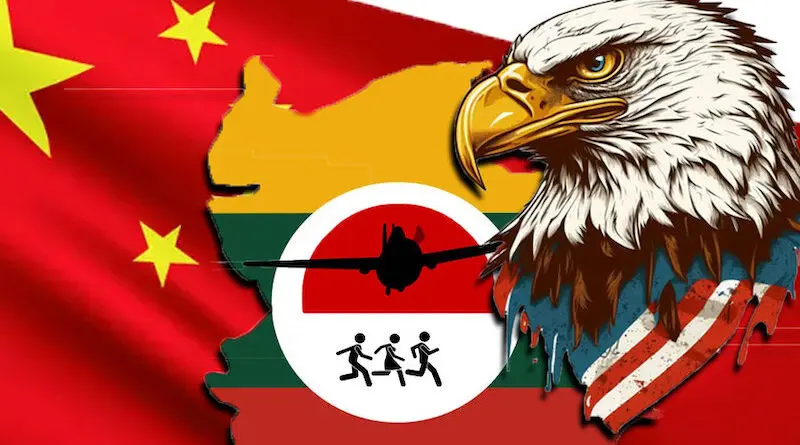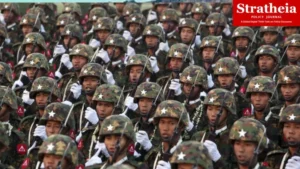Chinese Covert Intervention In Myanmar Amidst Possible Proxy War With US – OpEd
China may have attracted global attention by taking Donald Trump’s USA head-on in the escalating trade-tariff war, but there’s no way one can miss out on Beijing’s equally assertive but less publicised recent moves in Myanmar.
This at a time when China has come out in open support of the Burmese military junta which has lost control over much territory to a loose coalition of ethnic rebel groups and pro-democracy armed Bamar resistance outfits called People’s Defense Forces (PDF). China’s desperation stems from the poor performance of the Burmese army Tatmadaw amidst reports that the US is negotiating with Bangladesh to open a supply route to provide military, food and medical supplies to rebels in the Rakhine and Chin provinces.
China Brokers Lashio Deal
Lashio cultural tours
Reports have now emerged of a decisive Chinese not-so-covert intervention in the Myanmar civil war, where Beijing’s intelligence services has managed to broker a ceasefire deal between the Burmese military junta and the Kokang rebel Myanmar National Democratic Alliance Army (MNDAA) that will lead to the rebel withdrawal from Lashio town in northern Shan State by the end of April.
The Chinese city of Kunming, capital of the picturesque Yunnan province, has been the venue of talks between representatives of the military junta and rebel leaders who were initially reluctant even to declare ceasefire but were finally pushed into agreeing to withdraw from Lashio, a key town on the China-Myanmar Economic Corridor which was also headquarters of the Northeast Command of the Burmese army Tatmadaw.
Lashio was overrun by the MNDAA and its allies in the Three Brotherhood Alliance in late July last year and marked the first major rebel victory in the 1027 offensive unleashed by the Three Brotherhood Alliance beginning October 2023.
The successful capture of Lashio spurred other rebel groups to intensify their armed offensives against the Burmese military with the Arakan Army ( a constituent of the Three Brotherhood Alliance) capturing 15 of the 18 townships in the coastal province of Rakhine.
Junta Looses Rare Earth Mines
Up north, the Kachin Independence Army (KIA) also captured large areas of the Kachin state including the rare earth mines around Pangwa and Chipwe. Fighters of a recently united front of Chin rebels have in April overrun Falam, the second largest town of the Chin state bordering India’s Mizoram, whose chief minister Pu Lalduhoma played a key role in uniting the Chin groups into the new platform, Chin Brotherhood.
The phenomenal success of the rebel forces threatening to sink the once-powerful Burmese military understandably sent shock waves in China, which has invested heavily in Myanmar, not the least to gain a major land-to-sea access to the Bay of Bengal and thus to the Indian Ocean, bypassing what Chinese geo-strategists describe as the ‘Malacca chokepoint.’
Chinese Pressure on MNDAA Works
Immediately after the fall of Lashio, Beijing began to mount huge pressure on the MNDAA to start negotiations with the Burmese military junta, with its agents even holding the group’s supremo Peng Daxun in its custody in Kunming. Only after the MNDAA agreed to negotiate was Daxun released. The MNDAA, against the run of rebel victories all over Myanmar, agreed to a ceasefire and also to allow the lucrative border trade with China.
But China didn’t think it was good enough and mounted huge pressure on the MNDAA, even pushing the more powerful rebel group United Wa State Army (UWSA) to cut off food and other supplies to areas controlled by the Kokang group. Both the UWSA and the MNDAA have been traditionally cultivated by the Chinese in their dual-contact approach with both the military junta and the rebel groups.
The MNDAA has now agreed to a phased withdrawal from Lashio before the end of June as part of a deal with the regime brokered by China. But now there are indications that this withdrawal may happen as early as end of April, perhaps due to relentless Chinese pressure.
MNDAA sources in private conversation resent the imposed deal. One MNDAA leader described “loosing Lashio on the table after wimning it on the battlefield.” “Myanmar Now” website quoted a MNDAA source to say that the military junta will send civil servants from its general administration, education and health departments on April 22, but the MNDAA will retain some troops, its police force and a liaison office in Lashio. A resident told the outlet that many MNDAA troops are not happy with the planned withdrawal but are unable to stop it.
‘Myanmar Now’ reprted that the MNDAA has partially suspended medical services at Lashio General Hospital and may totally close it down before withdrawal. There are indications that the rebel group is taking away the hospital equipment to areas controlled by the MNDAA in northern Shan state .
Chinese Pressure Other Rebel Groups
Chinese pressure on other rebel groups was also discernible, though less successful . It failed to push the likes of KIA or Arakan Army to declare a ceasefire prior to the devastating March 28 earthquake. These groups have said they are holding fire to allow relief to the quake-affected people but will resume their military offensive by April end.
The KIA had closed the border gates but finally relented under Chinese pressure to open them to allow rare earths exports to China, from which the Kachin rebels now stand to gain much revenue. The Arakan Army, who like the KIA refused to declare ceasefire and have now pushed their offensive into the Burman heartland, have avoided attacking the China-funded deep-seaport of Kyaukphyu and the special economic zone around it. The Arakan Army leadership has promised to promote and protect foreign investments in Rakhine considered beneficial for locals. Analysts say this is a message to both China and India, which has invested much in the Kaladan Multimodal Transport project running through the Rakhine capital port town of Sittwe.
But the mainstream Burman armed groups organised into several People’s Defence Forces or PDFs , many swearing allegiance to the parallel National Unity Government (NUG), have been openly hostile to China over Beijing’s open backing of the repressive military junta. Chinese factories, mining leases and even an offtake station on the Yunnan-Rakhine oil-gas pipeline have been bombed.
Analysts say China may achieve some immediate gains like in the northern Shan State with groups traditionally dependent on its support but it can only protects its huge interests and investment in Myanmar if it manages a comprehensive ceasefire between the military junta and the many armed rebel groups. But that can only be achieved if the Army agrees to restore democracy through credible elections followed by a complete return to the barracks. Some would say the Burmese military junta is for the Chinese what the Najibullah was for the Soviets and the Ashraf Ghani regime for US in Afghanistan — a sinking ship difficult to keep afloat even with much external support.
US Moves in Bangladesh
Two senior US State Department officials , Nicole Chulik ( Deputy assistant secretary South & Central Asia) and Andrew Herrup (Deputy assistant secretary East Asia & Pacific) have arrived in Dhaka, accompanied by Susan Stevenson, charge d’affairs at US embassy in Myanmar. Among other issues, they are all set to finalise a supply zone for rebels in Myanmar’s Rakhine and Chin states to ensure complete defeat of the Burmese military. The Bangladesh Army was sounded out about this proposal during last month’s Dhaka visit of the Deputy Commanding General of US Pacific Command, Lt Gen J B Vowell.
The Bangladesh Army has already chosen a site — Silkhali– near the Naaf river to set up a massive supply dump. The Cox Bazar airport is also been extended for setting up a drone base to operate Turkish made aerial assets that may support rebels across the border.
Bangladesh’s interim government led by Nobel Laureate Mohammed Yunus, beholden to the US for an effective regime change operation that brought it to power, may be too willing to back the US game plan seeking to deny China the land-to-sea access from its southwestern Yunnnan province to the Rakhine coast in the Bay of Bengal. A similar Chinese plan to secure land-to-sea access to the Arabian Sea has been threatened by the escalating tribal insurgency in Pakistan’s province of Balochistan.
For Yunus, who seems determined to hang on to power without facing elections, supporting the US game plan might seem a small price to pay to please Washington and find a way to send back the nearly one million Rohingya refugees who have fled into Bangladesh. But it may drag Bangladesh into the Myanmar conflict and upset China which has welcomed investment opportunities and is planning to send a large business delegation to Bangladesh next month.

Subir Bhaumik
Subir Bhaumik is a former BBC and Reuters correspondent and author of books on South Asian conflicts.





